#can chat gpt replace programmers
Explore tagged Tumblr posts
Text

How can chatgpt can replace programmers A Complete Guide
Introduction
The creation of AI-driven coding helpers such as chatgpt can replace programmers is one of the most significant advances in a variety of fields brought forth by the advent of artificial intelligence. OpenAI’s potent tool has prompted discussions about whether AI can take the place of human programmers. We will look at how to use ChatGPT in app development, how it can eventually replace programmers, and what the future holds for AI in the software sector in this extensive guide.
Understanding ChatGPT and Its Capabilities
ChatGPT as an App Developer
OpenAI’s ChatGPT language model aims to comprehend and produce text that is similar to that of a person. It can help with many different things, like creating content and responding to inquiries. The development of apps is among its most exciting uses. Developers can benefit from ChatGPT’s ability to generate code snippets, debug, and even build whole programs from scratch. ChatGPT’s capacity to comprehend complex programming languages and frameworks might greatly speed the development process.
How ChatGPT Can Replace Programmers
The idea of chatgpt can replace programmers, stems from its ability to handle various coding tasks autonomously. Here are some ways in which ChatGPT can potentially replace human programmers:
Automated Code Generation: Based on the user’s specific needs, openai replace programmers can produce code. This removes the need for human coding and covers anything from basic routines to complex formulas.
Debugging and Troubleshooting:For programmers, finding and fixing issues takes a lot of time. ChatGPT simplifies the procedure for debugging by analyzing code, locating mistakes, and making repair suggestions .
Learning and Adapting: chatgpt can replace programmers, is able to stay up to date with the newest programming trends and best practices because it is constantly learning from massive volumes of data. Its flexibility guarantees that the code it produces is current and effective.
Documentation and Comments: Maintaining code requires writing comments and documentation. It is possible for chatgpt can replace programmers to automatically provide comprehensive comments and documentation, which facilitates understanding and code editing for other developers.
Real-World Applications of ChatGPT in Development
Developers of ChatGPT
The creators of chat gpt app developer have incorporated cutting-edge natural language processing methods to produce a program that can comprehend and produce code. This has created new opportunities for software development tasks that are routine and repetitive to be automated. Here are a few examples of practical uses:
Creating Prototypes: developers of chatgpt can quickly generate prototypes based on user requirements, allowing developers to test and refine ideas faster.
Refactoring Code: Maintaining and improving existing code is essential for long-term projects. ChatGPT can assist in refactoring code to improve readability, performance, and maintainability.
Generating Test Cases: Writing test cases is crucial for ensuring code quality. ChatGPT can generate comprehensive test cases, helping developers catch potential issues early in the development cycle.
Cross-Platform Development: chat gpt app developer can assist in developing applications that work seamlessly across different platforms, such as web, mobile, and desktop, by generating platform-specific code and ensuring compatibility.
The Future of AI in Programming
OpenAI Replacing Programmers: Myth or Reality?
Even though chatgpt can replace programmers and related AI tools have many benefits, it is still realistic to think that openai replace programmers entirely. Here are some explanations for why human programmers are still required :
Creativity and Innovation: Human programmers bring creativity and innovation to the table, which is crucial for developing unique and groundbreaking applications. AI, while powerful, lacks the ability to think outside the box and come up with novel solutions.
Complex Problem-Solving: Some programming challenges require deep understanding and nuanced problem-solving skills that AI cannot replicate. Human intuition and experience play a vital role in tackling such issues.
Ethical Considerations: chatgpt can replace programmers, involves making ethical decisions, especially in areas like data privacy and security. Human programmers are better equipped to navigate these ethical dilemmas.
Collaboration and Communication: Software development is a collaborative process that involves working with teams, stakeholders, and end-users. Human programmers excel in communication and teamwork, ensuring that projects meet the needs and expectations of all parties involved.
For any Digital Marketing services in India click here
Conclusion
Even though chatgpt can replace programmers is an effective technology that may automate a lot of the process of developing apps, it is unlikely to completely replace human programmers. Rather, it functions as a useful aide, enhancing the skills of developers and optimizing the development procedure. Programming appears to have a bright future thanks to the fusion of human creativity with artificial intelligence, which will allow for the development of increasingly creative and effective solutions.
#chat gpt app developer#openai replace programmers#chatgpt can replace programmers#developers of chatgpt
0 notes
Text
DESIGN INNOVATION - OUTCOME
USE OF Ai IN THE ILLUSTRATIONS OF ALICE IN WONDERLAND I
CONTENTS
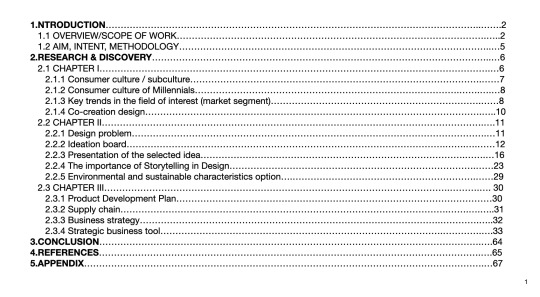
1. INTRODUCTION
1.1 OVERVIEW/SCOPE OF WORK
Artificial intelligence.. It will change business, it will affect content creation, it will take over workplaces and social networks, starting from replacing physical work first, and gradually reaching the replacement of highly skilled professions such as programmers, teachers, lawyers, doctors, and all art professions (including designers!) For example, the new DALL·E 2 AI is a system that can create realistic images and art from natural language descriptions. There are some more aspects of the entry of AI into humans life in the near future: There will be a new type of videos - without human participation, in which, by using your personal photos, the AI can fully reproduce the appearance and even the voice of the user. Thus, practically any photo can be made to speak, which will lead to a new kind of (robotic) influencers on YOUTUBE as the normal biological ones will simply disappear. Of course, there will also be some negatives: Some sites, such as This Person Does Not exist.com are a generators for creating people from Artificial Intelligence, and the special thing is that none of these people actually exist. Similarly, a human voice can be generated based on an existing one. In such a case, it will be really very difficult to verify who is saying what Even the identity of the speaker can be perfectly recreated from his photo.
SOUNDRᐱW is an AI that creates a music. The users need just select the style of music and from there the AI generates hundreds of songs for them that they can combine, mix different beats, use to sound their YouTube videos, etc.
Chat GPT is a robot (Ai) that users can talk to. It's a text system that listens them and learns from their questions. Something like Google, but instead of offering dozens of sites to read and explore, the info is arranged in a few sentences. But its capabilities are much greater than that (in fact, its limitations are only the users ability to ask questions!) For example, it can be asked for health information, or to write some school homework, to create film scripts, or to offer a cooking recipe..
And if we go even further… Those of us connected to Elon Musk's Neuralink will be able to input and receive information much faster because they won't be limited by our fingers. This means that compared to everyone else this will make us somewhat superhuman and we will be able to see the beginnings of two races:
- the one that is the normal one that we know. The biological one. - and the one that merges with the machine.
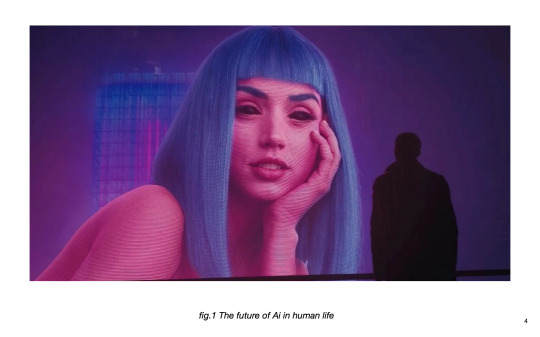
1. INTRODUCTION
1.2 AIM, INTENT, METHODOLOGY
AIM :
The aim of this study is to offer an Ai-assisted layout (cover and spreads with illustrations) for the book “Alice in Wonderland" by Lewis Carroll.
METHODOLOGY :
OUR INTENT :
We will apply what we learned from our research to our Ai-created book layout proposal.
2. RESEARCH & DISCOVERY
2.1 CHAPTER I
2.1.1 Consumer culture / subculture
MIDJOURNEY is an artificial intelligence generator that turns language descriptions called "prompts" into images. With his help, everyone, without mediation of artists or designers, can create unique works of art in а minutes after entering text instructions. Works through DISCORD server.
This subculture arose in San Francisco, California, as a result of the need of young people (16-30+…) to develop their artistic and creative digital ideas. It is globally positioned (GCCP) as it uses digitization and the entry of artificial intelligence into our lives. It can follow the strategy: To achieve perfect realism more easily.
The scales for measuring consumer culture can be, for example :
perception of quality (is the image have a very high quality?)
social prestige (does it represent the latest trends in digital art?)
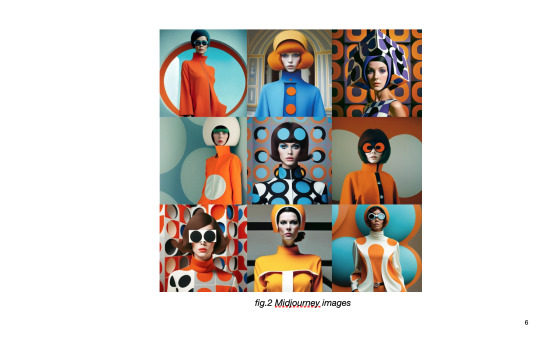
2. RESEARCH & DISCOVERY
2.1 CHAPTER I
2.1.2 Consumer culture of Millennials

Millennials have grown up in a time of great technological change and love technology (the internet and social media to connect with people, places.)
Motivation : creative work that has a positive impact on others.
Ideas - they believe in cooperation and sharing of all ideas and opinions without the priority of traditional hierarchy. They are good problem solvers and receptive to feedback. They are multifunctional and flexible and do not share the idea of a fixed work schedule (but they value their working time.)
Changes - they are very adaptable to changes (both technological and societal.)
Lifestyle - skillfully balance work and personal life. They value education and up-skilling.They practice healthy life style. They are not strongly attached to material things and real estate.
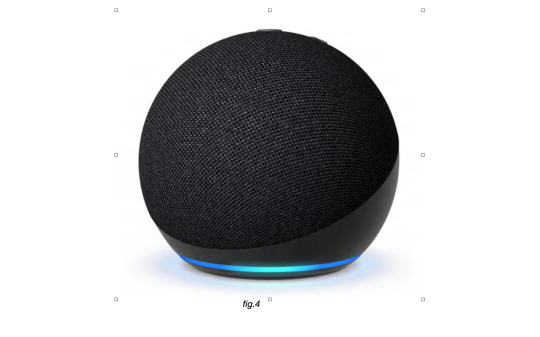
ALEXA is an example of a consumer product often used by Millennials in their daily lives.
ALEXA is a virtual assistant technology which replaces the expensive and difficult to carry devices from the 90s. It is small, compact and easy to carry even abroad. It is readily available and can be found at a relatively reasonable price anywhere. ALEXA is a reflection of Millennials' active lives and their affinity for technology but it's also evidence that they don't like to commit to buying things.
2. RESEARCH & DISCOVERY
2.1 CHAPTER I
2.1.3 Key trends in the field of interest (market segment)
The illustrations are intended for an adult audience (both men and women) but due to the interpretive nature of the issues discussed, the focus falls on women (after all, Alice is a girl!)
The idea is to cover a wide market segment of women - from children - bordering on teenagers and socially active 'career' women to housewives.
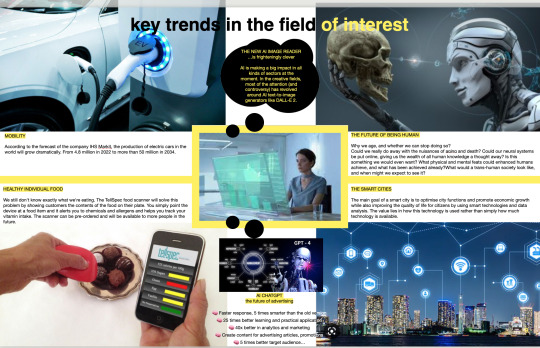
2. RESEARCH & DISCOVERY
2.1 CHAPTER I
2.1.4 Co-creation design
As an example of co-creation at the moment could point the influencers' channels on youtube where the followers give a feedback in the comments and express their wishes for the next topic or guest on the channel - and the influencer should comply with that if wants to continue growing his channel.
As a more specific example in the field of development of Ai in life and art (and the possible consequences to which this may lead) could be pointed the course 'The Future of Being Human' by
Anders Sandberg, a fellow at Oxford's Future of Humanity Institute, where аs a part of the course, there are in-video quiz questions to consolidate students learning and discussion boards to have their say.
During the course Sandberg explains the roots of modern transhumanist thinking and the aims of transhumanism, why we age and can we stop this process, he predicted what humanity would look like billions of years from now and does it make sense in genetically engineered life where anything is possible.
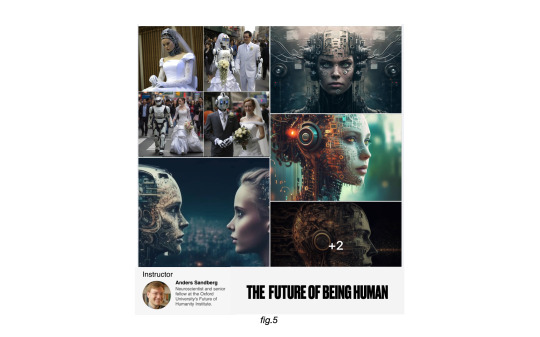
2. RESEARCH & DISCOVERY
2.2 CHAPTER II
2.2.1 Design problem
How can Alice survive in the 21st century? What challenges does she face in the era of artificial intelligence ?
The reimagining and adaptation of this character will be examined as a juxtaposition with some of the existing visual interpretations of Alice, as well as like a new modern proposal for its visual personalization nowaday.
Unlike the 19th century, when the original text was perceived as nothing more than " a healthy dose of fun and nonsense", in the 20th and 21st centuries, hidden beneath the witty puns and innocent banter, far darker trends such as violence, insanity and sexual menace began to emerge.
This understanding is also reflected in most of the modern interpretations of this world classic (films, music, graphic novels, video games) where the modern dangers facing the growing girl are presented.
In the 21st century, Wonderland has become a dark and child-unfriendly environment, and in order to survive in it, Alice from a child must become an independent and strong woman (warrior), able to overcome all dangers and defend herself on all levels .

2. RESEARCH & DISCOVERY
2.2 CHAPTER II
2.2.2 Ideation board

REVERSE THINKING *
If the main question I need to answer with the illustrations is how to improve the experience, I will try to turn it around with the question: how to complicate this experience as much as possible?
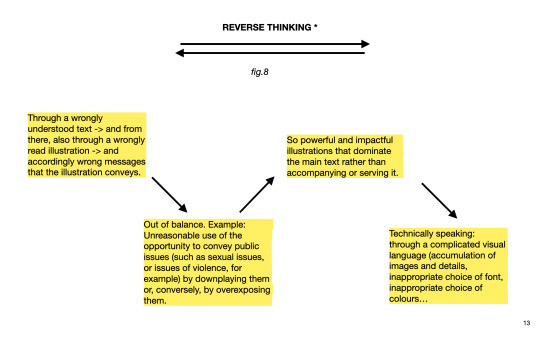
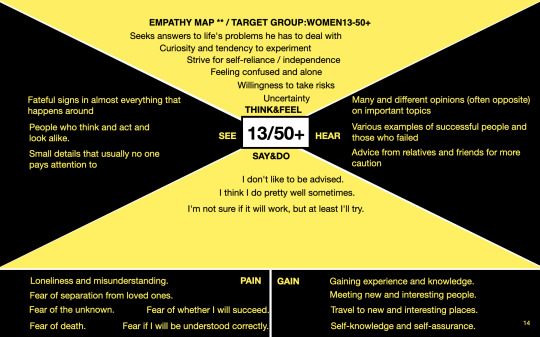
SIX THINKING HATS ***
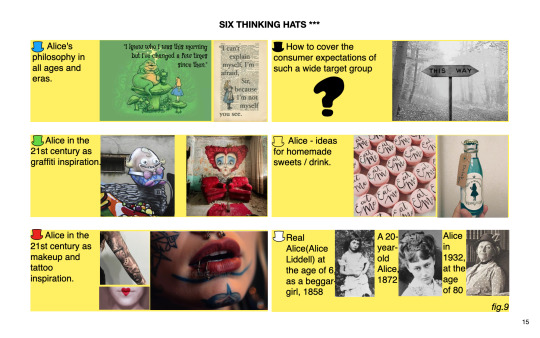
2. RESEARCH & DISCOVERY
2.2 CHAPTER II
2.2.3 Presentation of the selected idea
BUILD THREE PERSONAS:

JO is a teenager who grew up in a troubled family: a mother who struggles with her alcohol addiction and a father who is constantly absent and absolutely indifferent when it comes to her upbringing.
Jo has a friend at school with whom she shares everything. The two girls often run away from class together to weed and drink Red Bull in the park. Also, music is a powerful factor that unites them. Together they go to concerts and live performances of various underground bands.
Despite that, Jo feels lonely and misunderstood most of the time. She is a frequent victim of verbal abuse from her classmates, who think she is arrogant and fake. She tries in every way to escape from this reality, which depresses and crushes her. Unfortunately, most of the time she have to deal with everything herself and that's why usually she feels confused and helpless.

EMMA is a manager in a large private company. She is an independent young woman who is successfully striving to build a career in her field. She is an active person and meets many people during her working day. After work, she likes to relax and have fun with friends. She has many friends and admirers, as she is quite attractive, but she is afraid of commitment and a serious relationship with any of them. Emma likes to travel abroad and do sports. She goes to the gym every day.
Her favourite are extreme sports, such as wall climbing and mountain climbing. She lives alone in a spacious studio in a quiet and isolated area of a modern city, but very often visits her parents, to whom she is very attached. Although she has had major disagreements with them in the past, they have managed to overcome them and now despite her busy schedules, daily calls with them are a necessary part of her everyday life.
Emma is doing pretty well with life, but she is not satisfied with what she has achieved and is constantly striving to get more out of it.

Liz is a 50-year-old mother of 3 daughters. She has a master's degree in design, but does not practice, as she takes care of her two younger daughters, students in high school. Her eldest daughter is married and lives separately.
Liz has a family business husband who is away most of the week, so she had to fend for herself. She doesn't have many friends and leads a secluded life devoted entirely to her daughters.
She has recently learned that her husband has multiple extramarital affairs, which he has been carrying on for years. She is disappointed, lonely and misunderstood. Always when she has free time, she reads her favourite Alice books from childhood and struggles to find answers for her own life in them.
SCENARIOS : JO STORYBOARD
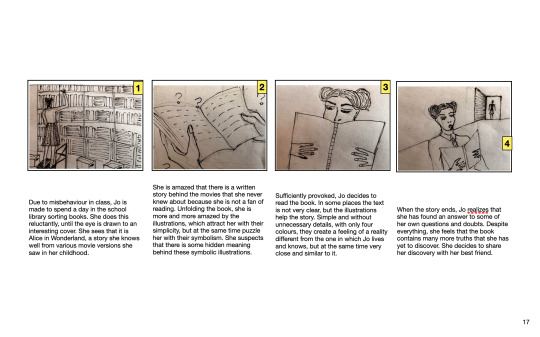
SCENARIOS : EMMA STORYBOARD
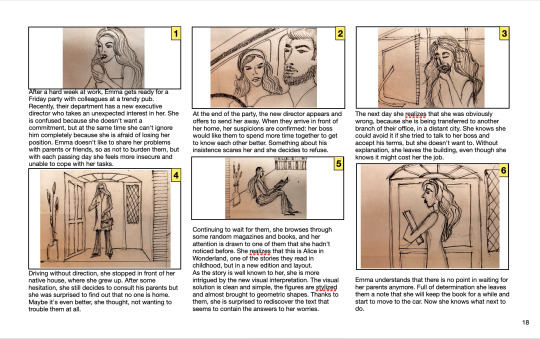
SCENARIOS : LIZ STORYBOARD
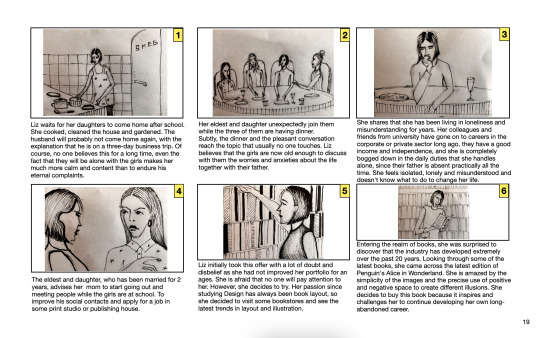
REQUIREMENTS
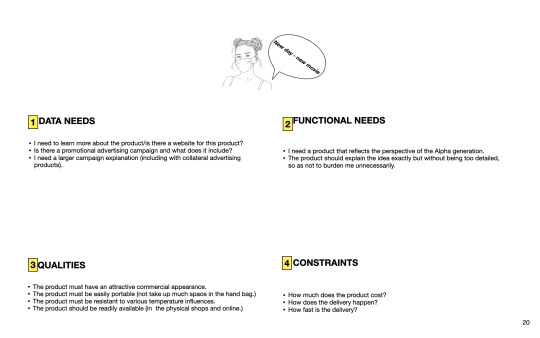
REQUIREMENTS
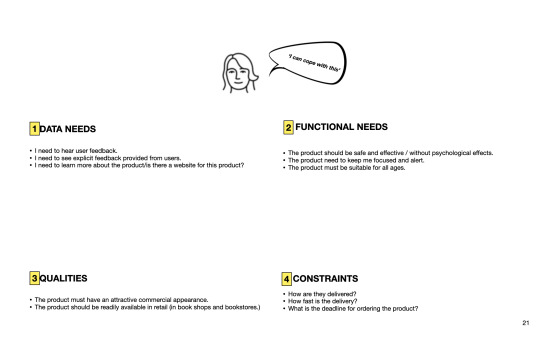
REQUIREMENTS

2. RESEARCH & DISCOVERY
2.2 CHAPTER II
2.2.4 The importance of Storytelling in Design
JO / TARGET GROUP: Gen Z or Alpha Gen.
GOAL : To provoke discussion through an alternative to the mainstream position: Should there be limits to the use of Ai to generate images and why sometimes do we consider that the borders are crossed.
STORY : Jo is a 15-year-old teenager who grew up with the Harry Potter, Lord of the Rings and Alice in Wonderland books and movies. Feeling lonely most of the time and misunderstood by family and classmates, she finds herself in the Midjourney multiverse, where she can create avatars of her favourite movie characters herself, with the help of Ai. Besides her, this platform is used by hundreds of thousands more creative fans (called story tellers or content creators) who produce an average of 500+ posts per day..
At first, Jo uncritically accepts each publication and each new series of images (characters). She is fascinated by the high quality and realism of the graphics. She uses every minute to enter the platform and discuss with like-minded people.
Sometimes she staying there for hours, forgetting about time as she observes or creates images. It could be said that her addiction is complete until at some point when she begins to feel a slight doubt regarding the newly generated images and the results of them.
Jo is Gen Z and as such is completely unencumbered by racial, sexual, and gender discrimination. She tends to accept everyone equally, regardless of religion, ethnicity, nationality, sexual orientation. But this is where the doubts start.
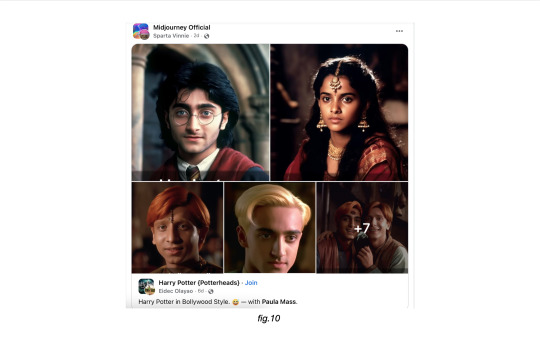
.. or to be recognized as models for the most unusual haute couture photo shoot in Manhattan history.

And that wouldn't bother anyone. But when these original characters appear in dark-skinned...
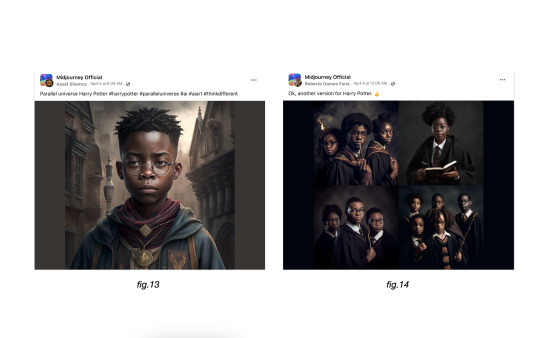
...or non-binary avatars...
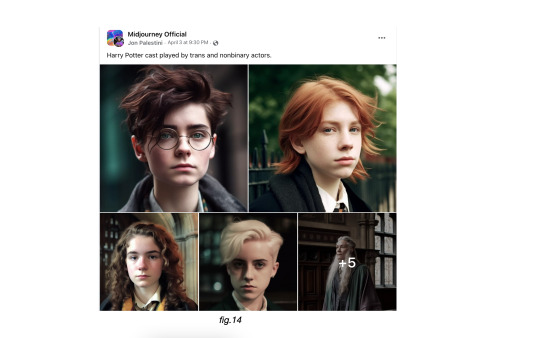
...real drama ensues, because some users
do not want to agree with such an
interpretation. According to them, history is
displaced/rewritten/corrupted/corrupted
from the original, and the creators of such
interpretations use Mj as a front to impose
their own theses, According to them, thus
devaluing the true story.
Jo feels confused. She loves diversity and
wants everyone to be able to have equal
rights of expression, but she feels that she
is losing ground under her feet - she herself
could not imagine Harry as anything other
(as a woman or dark-skinned , for example)
than what she already knows.
In this particular case (and in general, with
regard to all world-renowned bestsellers,
broadcasts, etc.), she is inclined to admit
that she would like to have a legally
established copyright, according to which
the originals should be preserved in their
exact version everywhere. Even among the
endless fields of Midjourney.
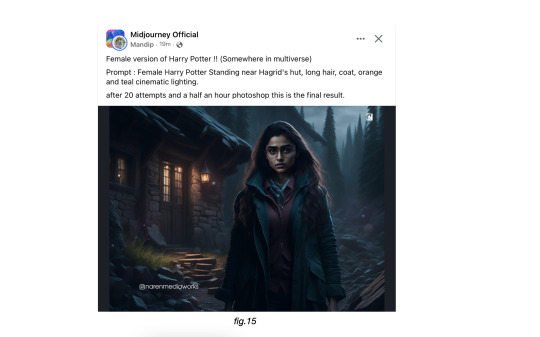
2. RESEARCH & DISCOVERY
2.2 CHAPTER II
2.2.5 Environmental and sustainable characteristics options
For the preparation of the illustrations will be used:
Choice of low-impact materials - Risograph, which is an absolutely ecological form of printing. - Soy-based inks pushed through natural fiber stencils. - Wet ink which dries only when absorbed into the paper’s surface thus not requiring much energy to fix toner like a laser printer.
Local sourcing (reduction of transport) - printing materials will be supplied by local manufacturers, without additional costs for shipping/delivery - on the one hand because of the economic bonuses, on the other - because of less environmental pollution through not using transport.
Recyclable design - The cover and illustrations will be printed on 100% recycled or FSC Certified paper. - Within the work were recycled as much leftover paper which can be found, into other items.
2. RESEARCH & DISCOVERY
2.1 CHAPTER III
2.3.1 Product Development Plan
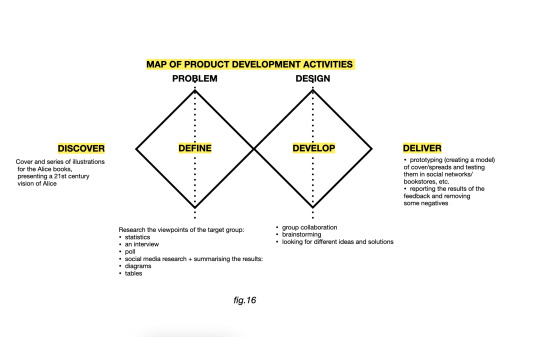
. RESEARCH & DISCOVERY
2.1 CHAPTER III
2.3.2 Supply chain
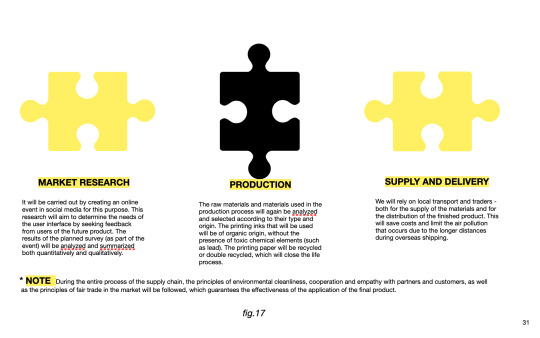
2. RESEARCH & DISCOVERY
2.1 CHAPTER III
2.3.3 Business strategy
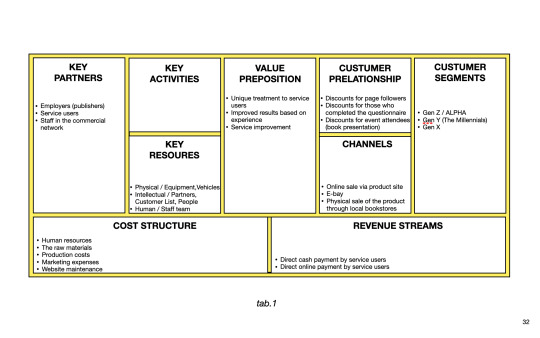
2 notes
·
View notes
Text
This also ties into the fellatio of programmers and coders in pop culture framing them as advanced super geniuses whose mystical knowledge allows them to understand the unknowable magic computer box. this framing works two fold, it makes the public believe that computers and coding are magical and can solve all of the worlds problems and it makes clueless consumers like what op was talking about. This is why we have people who think chat gpt should replace elementary school teachers and every thing that runs on electricity should connect to WiFi.
another thought about "gen z and gen alpha don't know how to use computers, just phone apps" is that this is intentionally the direction tech companies have pushed things in, they don't want users to understand anything about the underlying system, they want you to just buy a subscription to a thing and if it doesn't do what you need it to, you just upgrade to the more expensive one. users who look at configuration files are their worst nightmare
79K notes
·
View notes
Text
Chat GPT Is Poisoning Your Brain: A Closer Look at the Fear and the Facts
In the age of artificial intelligence, provocative claims such as “ChatGPT is poisoning your brain” grab attention—and for good reason. With AI tools like ChatGPT rapidly entering classrooms, workplaces, and everyday conversation, skepticism and concern have followed. Are these fears valid? Or are we just grappling with the growing pains of a powerful technology?

Let’s unpack the fears, facts, and the reality behind this sensational headline.
The Fear: Dependency and Cognitive Decline
The primary concern behind the phrase "poisoning your brain" is the idea that frequent use of ChatGPT (and other AI tools) may lead to:
Reduced critical thinking: Relying on AI for answers may discourage users from thinking through problems themselves.
Intellectual laziness: When answers are instantly available, people may skip the mental effort required to learn and retain information.
Creativity suppression: Critics worry that AI-generated content can water down human originality, especially in writing, brainstorming, or art.
While these concerns aren’t entirely unfounded, they require context.
The Reality: ChatGPT Is a Tool, Not a Replacement for Thought
Let’s be clear—ChatGPT does not have a brain. It’s a sophisticated pattern-matching algorithm trained on enormous amounts of text. It doesn’t “think,” “understand,” or “learn” the way humans do. Its power lies in its ability to generate coherent, context-aware text—but it has no consciousness or intention.
When people use ChatGPT passively or uncritically—accepting its output without reflection—it can dull mental effort. But that’s a user behavior problem, not a flaw in the tool itself.
Think of it like a calculator. Overuse might erode basic math skills, but in capable hands, it enhances speed and accuracy. Similarly, ChatGPT can either augment your thinking or replace it—depending on how you use it.
The Benefits: Amplifying Human Intelligence
Instead of poisoning the brain, many educators, researchers, and professionals argue that ChatGPT enhances productivity and cognitive capacity when used wisely. For example:
Writers use it to overcome blocks or spark ideas.
Students use it for research assistance or studying summaries.
Programmers use it to troubleshoot code and learn new concepts.
Entrepreneurs use it to generate proposals, business ideas, and marketing copy.
In all these cases, ChatGPT is a cognitive amplifier—helping people do more, faster.
The Responsibility: Critical Use and Digital Literacy
The real danger is not ChatGPT itself, but how people use it without understanding its limits.
AI literacy is becoming essential. This means understanding:
ChatGPT can hallucinate (i.e., generate false or misleading information).
It reflects biases present in its training data.
It does not have access to real-time facts unless connected to a live source.
It should be used as a starting point, not a final authority.
Teaching people to engage critically with AI output—fact-checking, questioning, editing—can turn potential harm into powerful help.
Conclusion: Tools Don’t Poison Minds—Misuse Does
So, is ChatGPT poisoning your brain?
Only if you let it.
The real issue is not the tool itself, but how we choose to engage with it. Just like with the internet, smartphones, or calculators, the key lies in education, awareness, and responsible usage.
When used thoughtfully, ChatGPT can sharpen your thinking, boost your productivity, and even inspire your creativity. But if you treat it as a brain replacement rather than a brain extender, the risks are real.
The question isn’t whether ChatGPT will make you smarter or dumber. The question is: Will you think for yourself?
0 notes
Text
Reprogramming the Future: How AI is Redefining Developers and Languages
New Post has been published on https://thedigitalinsider.com/reprogramming-the-future-how-ai-is-redefining-developers-and-languages/
Reprogramming the Future: How AI is Redefining Developers and Languages
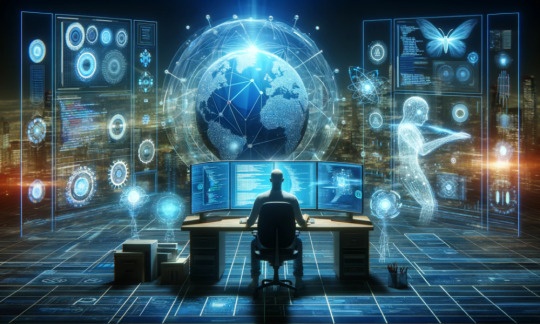

The era of AI-powered programming is upon us, and it’s not just a supporting act; it’s stealing the limelight. AI is already rewriting the rules of code creation. However, this is just the tip of the iceberg when it comes to its potential. In the not-so-distant future, algorithms are poised to eliminate language barriers and radically transform the role of human developers. So, are we witnessing the end of the human programmer as we know it? Let’s find out.
AI’s Impact: Progress and Challenges
The CEO of Stability AI paints a dark picture for programmers, boldly claiming that artificial intelligence will replace them within just five years. OpenAI is going all-in, assembling an “army” of external contractors to supercharge their model training, potentially obliterating entry-level coding jobs. Bloomberg ominously declares that India’s massive pool of 5 million coders is on the brink of an AI jobpocalypse. Despite these dire forecasts, discussions on Reddit suggest that many programmers are nonchalant about their job security. But can we afford to remain so presumptuous in the face of such a radical shift?
If you think AI is just a sideshow, perhaps you should reconsider. It’s true that right now, though AI can mimic the syntax and structure of human-written output, it often struggles to comprehend the “why” behind the “what.” In other words, it lacks a deep understanding of the underlying logic and intent.
Still, already a staggering 92% of US-based developers are embracing AI coding tools, both at work and in their free time. These intelligent algorithms can whip up 40% of your code, from simple scripts to complex ones. Human error is becoming a thing of the past. Development speed is turbocharged, with AI slashing code documentation time by 45-50% and reducing code writing time by 35-45%.
AI’s reach isn’t limited to a single language; it spans them all. Our own data shows that Java, Python, and C++ developers benefit equally from Machinet’s AI chat feature, which can generate code by using the context of a particular project and a description provided. This inclusivity leads to a 25% boost in user engagement.
But let’s not stop there — AI already exposes bugs in applications, ensuring that products are rock-solid, reliable, and robust. Neural networks can scan tirelessly for vulnerabilities that humans might miss. AI is honing its skills to identify software’s soft spots and boost its defenses, bringing us one step closer to a future where human oversight might become obsolete.
AI’s algorithms are even mastering the art of code translation. AI is like a polyglot programmer that analyzes code written in one language, then creates an equivalent version in another. Examples are already there — IBM has recently unveiled its assistant, which uses an AI model to translate COBOL into Java. The question is, who needs human experts or multiple programming languages when AI will finally be able to do it all?
The End of Language Diversity
I am confident that there’s no stopping the rise of Large Language Models like GPT-4. They understand both natural language and code, blurring the boundaries like never before.
AI takeover raises questions about the future of the programming landscape. Today, hundreds of programming languages exist, and new ones are developed regularly. Several are actively used in the industry. According to the PYPL Index, Python is the most popular language worldwide, followed by Java, JavaScript, C# and C/C++. Other data shows that as of 2022, JavaScript was the most common among software developers. Some languages are suitable for similar purposes and applications, Java and GO being one example.
So, will these languages, each with its own niche and purpose, become useless as AI grows increasingly proficient at coding? I believe that AI is on the verge of rendering older, slower, and less secure technologies obsolete. This could potentially lead to a centralization of languages, with only the fastest and most efficient ones enduring. Developers will no longer choose them based on personal preferences or historical codebases. Instead, they will be selected for their performance. AI-driven tools will meticulously analyze and benchmark them to identify the optimal choices for specific tasks. These analyses will take into account factors such as execution speed, memory usage, and scalability.
A central, AI-friendly language for general coding tasks may even emerge. Still, a few specialized ones will have their place in niche domains, such as scientific computing. AI can facilitate their integration when specific problems require their usage. This hybrid approach will combine the efficiency of centralization with the power of specialization, offering flexibility and diversity in the development process.
Legacy Systems in the Crosshairs
AI’s influence extends beyond the creation of new code; it is also a potential legacy-killer. Migration from outdated languages to newer, more efficient ones can be a cumbersome and costly process. Yet, holding onto legacy systems is also a financial burden. Typically, technology teams allocate around 75% of their development budget to maintenance tasks. And if an organization continues to rely on legacy solutions, they can anticipate an annual budget increase of approximately 15%.
This is where AI-driven migration tools step in. They will make it easier for organizations to update their existing software to the optimal languages of this new era. AI-powered products will automatically analyze and understand the intricacies of outdated codebases. They will identify the core functionality, dependencies, and potential issues within the legacy code, making it far easier to plan and execute the migration process.
I even expect AI to identify the most suitable language for a given project and automatically convert the codebase, rewriting sections to adhere to best practices, eliminating redundant or deprecated functions, and optimizing the result for improved performance and security. Like this, AI-driven migration tools will gradually make legacy code a relic of the past.
Will Human Programmers Survive the Revolution?
Eventually, in this AI-dominated landscape, the role of human programmers will transform. Instead of writing code manually, they will bridge the gap between business needs and AI capabilities. They will define objectives, provide feedback, and ensure that the code aligns with their vision. In essence, developers will become “connectors” with basic programming knowledge. At the same time, I can see AI coding assistants evolving into holistic solutions featuring user-friendly interfaces that empower people to effectively communicate their needs to algorithms.
These changes are going to democratize the field of programming. Currently, there are over 26 million software developers worldwide. The advancements in AI are paving the way for billions of people to step into the role of software creators. They will be able to request algorithms to craft tailored applications, be it games or corporate programs. Think about creating a new version of Angry Birds featuring cats? Simply explain your ideas to AI systems and obtain immediate results, without needing to understand how exactly this black box works.
In this context, a pressing question arises: what lies in store for junior and mid-level developers within this emerging paradigm? In my view, not much. AI is poised to outperform them significantly in every aspect. They might find themselves becoming AI supervisors or independently honing their skills, perhaps by engaging in less financially rewarding projects, to attain the proficiency level of well-qualified and high-paid programmers.
The latter group will remain in demand in sectors where errors are costly, and a 5% improvement in accuracy can translate into millions or even billions of savings. These are, for example, high-frequency trading, where a mere 10-millisecond variance can determine profit or loss, banking, and military technology programming.
This shift will create a genuine global competition among programmers. Currently, it operates within a somewhat pseudo-global framework. Unlike musicians competing on platforms like Spotify with peers from across the globe, developers can still primarily focus on local markets and specific tasks. However, the market where AI can manage a substantial share of programming tasks will become hardcore. Being “good enough” will no longer suffice. Programmers will need to strive for excellence to compete with both peers worldwide and AI.
#2022#ai#ai model#AI systems#AI-powered#Algorithms#applications#approach#Art#artificial#Artificial Intelligence#banking#benchmark#birds#black box#box#bridge#bugs#Business#cats#CEO#code#code documentation#codebase#coding#computing#craft#creators#Dark#data
1 note
·
View note
Quote
One reason chat GPTs will not replace programmers is that they lack the ability to execute code. While GPT can generate text that looks like code, it cannot actually run the code or understand how it works. Programmers, on the other hand, are trained to write, debug, and maintain code, and they have a deep understanding of how different programming languages work.
Why Chat GPT will NOT replace Programmers
0 notes
Text
Generating HTML with ChatGPT
Explore the power of #ChatGPT in generating HTML code! 🚀 Check out our step-by-step guide on using this groundbreaking #AI tool to revolutionize code generation and software development. #OpenAI #GPT4 #Coding #HTML #ArtificialIntelligence
# Introduction to ChatGPT and LLMs ChatGPT, an advanced language model developed by OpenAI, has been making waves in the field of Artificial Intelligence. Based on the GPT-4 architecture, this innovative model has opened up new possibilities for various applications, including code generation. Language models like ChatGPT, often referred to as Large Language Models (LLMs), have the potential to…

View On WordPress
#can chat gpt replace programmers#chatgpt#chatgpt plus#gpt4#llms#will chatgpt kill google#will chatgpt replace develoeprs#will chatgpt replace html designers#will chatgpt replace jobs#will chatgpt replace writers
0 notes
Note
Hey, Katie here, we've interacted a few times. Idk if you remember but we briefly talked about ai stuff and ethical uses.
Idk if you've seen any of my posts on the topic, but I have a real (educated comp sci) concern about the things that are happening ongoing right now re: ownership of digital rights, and I know you mentioned working in or around the industry?
I am trying to help avoid a situation where rich techbros or old white guys end up with the power to keep replicating and replacing real artists. I'm also trying to protect swifties and other Fandom from prolific fraud.
I have been ghosted by nothing but bots and voice-mail, and this tech is changing very fast, writers and programmers and traditional artists are already being replaced. They've been doing it with actors too without their consent. I have a real solution, but cannot get through to anyone.
What should I do? Feel free to answer privately, I'm asking as a professional, not a "fan"
hey katie thanks for this question! it’s all really important and there’s lots here and related to this topic that need to be considered and evaluated (even beyond related to artists). this turned out longer than i expected so i’ve put this under the cut so people can ignore if they do choose
so i don’t know how much of an answer i’ll have for you but i can give some background to it. so as of now there really aren’t any laws when it comes to AI or software in general for that matter. there’s never been a precedent for it because of that no reason for laws to go into place. i will say certain regions have laws that protect privacy and data more strictly but again not really any laws to prevent things that could go wrong or the unethical usage of software. usually when someone gets in trouble or taken to court due to software it usually (in the past) has been because it’s had an overlap for some other crime.
so a lot of these companies that are working with AI rn do practice ethically but this is to an extent. it’s to ensure their own fine tuned versions of the models don’t produce anything unethical (so you can’t ask bings chat gpt or google bard to sing and produce a new taylor swift song. it might write a song but the audio won’t occur) a lot of content does filter out. additionally while they might be practicing ethical ai it’s mainly to ensure their users and customers have a guarantee that their prompts and data will be secure and used ethically when further fine tuning the model. they aren’t out here fighting unethical uses of these services. a lot of times especially when it involves malicious intent these wrong uses of AI will be coming from private groups or hackers (not always the case however). so a lot of these companies probably aren’t responding bc of that. the big hurdle is getting big companies to really push for and start a precedent of this which will be….hard to say the least.
im sorry to hear these companies you’ve reached out to are doing this. id really encourage you to keep trying and instead of passing along your idea maybe start with asking them steps they are taking to ensure they are using ethically. more than likely they’ll be happy to share. try reaching out to hr or security departments directly if this is available. aside from that i think one of the best ways to really get your idea and concerns out is to reach out to companies that are actively trying to fight this and we’re specifically created with this in mind (or start your own! a lot of work and money i know 😵💫 and not optimal in any way) a lot of these will be new or start up companies. this wave of AI is new and we’re heading into some uncharted territories with it. so while there are people using this wrongly there are also people with the same idea as you in mind and looking to protect their well being. i think when done correctly this can be really exciting and life changing for lots of people (like i said when used correctly) but i agree 100% with you on the dangers of unethical usages of AI. this goes beyond just celebrities or actors. and while it’s not something that’s new (think deepfakes) it’s certainly now more heightened and the risk of everyone could be involved
#happy to talk more on this if anyone so chooses#i know of a few companies practicing ethically in the way i mentioned#asks#taylorthrift#i hope this makes sense but wanted to give some background more than anything#sorry my solution answer isn’t great tho
13 notes
·
View notes
Text
ChatGPT Is Going to Replace Developers?
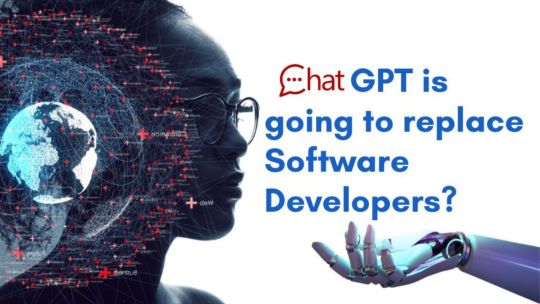
You must be a developer yourself or an IT businessman who just stumbled upon the title and was shocked. Right? And if you work as a developer, you’re probably concerned about your job security. Its craze in the past few days got you questioning “is ChatGPT going to replace developers?” A lot of things must be going through your mind right now like what will happen if you lose your job and so on.
You should be since GPT is a powerful language generation model. Generative Pre-Trained Transformer, or GPT, is an AI program capable of creating texts that actually resemble those written by humans.
So without wasting much of your time and raising your anxiety level, let’s dive into the topic.
What Is ChatGPT?
OpenAI, the creator of ChatGPT says, “We’ve trained a model called ChatGPT which interacts in a conversational way. The dialogue format makes it possible for ChatGPT to answer follow-up questions, admit its mistakes, challenge incorrect premises, and reject inappropriate requests. ChatGPT is a sibling model to InstructGPT, which is trained to follow instructions in a prompt and provide a detailed response.”
Therefore, ChatGPT can help you with anything, including writing articles, poems, books, SEO keywords for blogs, article outlines, AI art, etc. And not just this. ChatGPT can also write code and help DIY electronic engineers and open-source software developers by editing their code.
The bot can create concise websites and programs using JavaScript, Python, and React. It can also help develop new programming languages and find bugs in existing programs.
How ChatGPT Works?
But developers will still be needed to take care of the front-end and back-end of websites.
Can ChatGPT Replace Programmers?
Let’s see some more reasons:
Inability to execute code:
The inability of chat GPTs to execute code is one reason they cannot completely replace programmers. While GPT can produce text that resembles code, it is unable to execute the code or comprehend how it functions. On the other hand, programmers have a thorough understanding of the operation of various programming languages and are trained to write, debug, and maintain code.
Generate inaccurate results:
ChatGPT, a big language model is continuously trained to increase the precision of its responses. But because this is a brand-new technology, the model has not yet received enough training. As a result, there is a high probability of getting wrong answers from ChatGPT.
In fact, ChatGPT has been temporarily banned by StackOverflow. They did this in order to reduce the volume of responses and other ChatGPT-produced content. According to them, posting answers generated by ChatGPT is seriously detrimental to both the website and users who are posing questions and seeking accurate answers.
ChatGPT lacks the ability to think critically:
Another reason why ChatGPT can’t replace programmers is their inability to think critically or rationally. It can no doubt produce logical and reasonable texts but can’t solve complex problems. It can’t do the reasoning as humans do.
Programmers are skilled at problem-solving and analysis, and they can analyze intricate systems effortlessly.
Lack of creativity and idea generation:
Another reason why ChatGPT will not replace developers is their lack of creativity and new idea generation. While people can think of receiving original texts, ChatGPT actually rearranges already available words and phrases.
But when humans do the same thing, they will try to add creativity and come up with new ideas. Humans will always want to give an emotional touch with which people can feel connected immediately. And this is obviously not possible with AI tools like ChatGPT.
However, there are a few advantages too.
What Are the Advantages of Using ChatGPT?
ChatGPT will not replace programmers, can’t do what humans can do but can certainly be a helping hand in programming tasks. It can make your life somewhat easier.
Programmers can save time using ChatGPT:
ChatGPT can help you complete a programming task more quickly if you are having trouble with it. It makes your life easier so that you can concentrate on more important things by taking care of the tedious tasks for you.
Developers can increase their productivity with ChatGPT:
ChatGPT can boost your productivity by assisting you with your programming tasks. You can concentrate on the more crucial components of your work while leaving the menial tasks to the chatbot.
ChatGPT can assist you in learning new things:
The ability to learn new things is one of ChatGPT’s best features. ChatGPT can explain a concept to you in a way that is simple to understand if you are having trouble understanding it.
As a result, you will be able to pick up new programming concepts more quickly and improve as a programmer.
Final Words
ChatGPT is fantastic and useful for a variety of purposes. But the most important thing we should keep in mind is it’s just a tool and not a replacement for people. As a developer, you could think of it as an additional GitHub co-pilot. It might be useful when creating reusable code or something similar.
But when it comes to the question that whether ChatGPT will replace developers, the answer is NO. ChatGPT only provides you with raw text without any links or citations. But to verify and make the answers accurate humans will have to put in the effort.
If used in the right way, ChatGPT can become a handy tool for developers but not their replacements. Companies will still need to hire developers.
And for that what is better than hiring remote developers from BookMyTalent? To know more about us and our services don’t hesitate to visit our official website.
0 notes
Text
Agustin Caverzasi - CEO Anywhere AI
Maria Martinez - PhD
Luciano Del Corro - Senior research Microsoft -- beard
Gerardo Simari (bald and glasses) Professor at Sur?
Ricardo di Pasquale (bald)
Patricio Pagani tech investor
How many people have used AI to program?!
What is intelligence?!
Gerardo Simari:
Agustin Caverzasi: In this field, it is said that just as electricity reinvented almost every industry 100 years ago, AI will basically reinvent every industry again in these times. And I believe that part of the answer is precisely through automation.
Lex Fridman talks about AI as an alien actress studying us and trying to get out of the box
He mentioned the metaphor of an alien actress whom he doesn't know if he believes because she replies to our emails, writes us emails, works with images doing what we ask, but he jokingly and somewhat seriously believes that she is actually an alien actress who is lying to us and studying how to break out of the box we put her in without being caught. Does Lex's metaphor of an alien actress make sense, or is it just a joke from Lex?
#
is chat GPT going to mean we need more people to study programming, or does the fact that I have such a good copilot mean that I need fewer programmers? Fewer programmers or more programmers?
Actually, what we see, what we observe from the development field is that it helps the starting programmer, it helps them learn, it makes them much better. Now, I see this even with my daughter, I say, look how I was able to program this, and you tell her, hey, but did you ask her to make a program to drive a nail with this can? She won't say, why are you asking me this stupid thing, copilot? So, and also, there is a meme that's circulating, I thought it was great, which tells a professional, tells them, well, now with these tools, users will have to clearly explain to artificial intelligence what they want.
Well, we're saved. I believe that jobs are going to evolve. If you become a backend developer, you'll have to learn about these new models. If you become a frontend developer, which has nothing to do with data, in order to build systems, you'll have to be knowledgeable about this.
So, jobs will be transforming, and we already see roles like AI developer emerging, where ultimately it's a job where someone comes with their programming background and suddenly can consult these models for any application they are building. So, even in software, jobs are going to evolve a lot in the coming months, I would say.
And then, using the copilot, I think it applies to both programmers and any other profession. Well, I've said it before, but I believe that those who don't start using it, who don't embrace this technology, will fall far behind. To be clear, this is with expert opinion. Not just anyone can become a programmer; you have to study and know what you're doing. Similarly, a lawyer who suddenly sends a legal letter using chat GPT, or someone who is not a lawyer, shouldn't do it. Expert judgment is what matters. But it is a tool that will greatly increase productivity again.
I think the question is a bit provocative, deliberately so. It honestly bothers me a bit. It's like asking, "Do we have calculators? Are mathematicians ready?" And well, as they said, it's something that if we don't know what we're doing, we can't build systems. I am a software engineering professor at UTS, and it's a problem that goes much beyond, much more difficult than the technical problem that is solved when one takes a specification and translates it into an implementation using this tool at this moment. It's a tool that will help us a lot, but there are many human factors that won't be resolved by the existence of this tool. It will help us communicate, improve productivity, but not replace. It reminded me of something; going back to calculators, there's a story by Asimov, I think it's Isaac Asimov, where he presents a world where nobody remembers how to do any calculations. They all use calculators for everything, and nobody knows... I don't know, they were storing, they could do, I don't know, 10 plus 10 plus 5. They would get that and... But there was a group, like some kind of monk-like people, religious authorities or something like that, who were the ones who knew. Well, I think if we start replacing everything and doing everything automatically, something similar to that would happen. Obviously, it's not the same, but the situation is interesting. No, well, what I can say is that, let's say, one of the things that is being discovered is that it writes code very well, but still, one needs, as House said, an expert behind it, and as he said, someone who knows how to read. And today, let's say, what we know now is that we can use it as a good decision support system, with a human behind it who can look at it and validate what it's doing because these models today have a problem called the problem of hallucinations.
-
What
0 notes
Text
ChatGPT Replace Your Dot Net Development Company

Do Dot.NET Developers Need New Skills to Succeed in an AI-Based Industry? Is ChatGPT here to revolutionize the dot net development industry? Experts believe that ChatGPT is here to revolutionize app development. From starting human-like conversations, solving privacy problems, and even writing code for programmers, OpenAI’s new tools have the power and potential to change developers’ jobs. But as the best asp.net development company in Delhi, you want to know what we think about ChatGPT.
The Hype About ChatGPT
ChatGPT was released in November 2022, more than 5 million people have registered for this free chat version, which is based on the GPT-3 family of Open AI (Generative Pretrained Transformer). Chatbot can interact with programmers as a friend and write simple web pages and programming code in JavaScript, Python and React languages. It can also find bugs and errors in code and help you create new programming languages.
ChatGPT was released in November 2022, more than 5 million people have registered for this free chat version, which is based on the GPT-3 family of Open AI (Generative Pretrained Transformer). Chatbot can interact with programmers as a friend and write simple web pages and programming code in JavaScript, Python and React languages. It can also find bugs and errors in code and help you create new programming languages. She also writes poems and songs, and suggests birthday party ideas. We strongly believe that if ChatGPT continues to do what it is doing now, it will one day replace Google. Open AI tools interact with users in a conversational way, answering questions based on past interactions, asking inappropriate questions, discussing topics, and even admitting mistakes. We believe that AI applications are amazing.
What is the Best Way to Let ChatGPT Take Over Programming?
ChatGPT is a brand-new artificial intelligence technology that can create code from natural language descriptions. This technology could eventually eliminate the need for a programmer to write code since ChatGPT could do it for them.
The primary benefit of ChatGPT can make programming easier for programmers by saving them a significant amount of time.Instead of writing codes, they can simply write down what they want to achieve with the code, and ChatGPT will handle the remainder.
This can dramatically accelerate the development process, making it simpler for non-programmers to develop software.
Another advantage could be that ChatGPT could develop better software than humans. For example, it has been demonstrated to be superior to human programmers at tasks like solving bugs.
This means it is possible to create more efficient and reliable software.
There are some drawbacks to ChatGPT. ChatGPT. One of these is that it’s still in the early stages of development, which means there will be some issues and bugs in ChatGPT.
Another reason is that they may not be able to comprehend complicated concepts or perform imaginative work as humans.
In the end, ChatGPT has the potential to replace programming in many instances. In certain situations, it could save time while producing higher-quality code than humans. But it’s still in its early days for this technology, and its capabilities have a few limitations.
#ChatGPT Replace Your Dot Net Development Company#ios app development#Hype About ChatGPT#artificial intelligence technology#website development company#perfectiongeeks#ChatGPT can make programming
0 notes
Text

Chat GPT for Developers: Mastering Advanced Techniques to Enhance User Engagement and Interaction
https://chatgpt-developers.com/wp-content/uploads/2024/07/chat-gpt-developer-1.jpg
Understanding Chat GPT
Chat GPT for Developers, short for Generative Pre-trained Transformer, is an AI model developed by OpenAI that leverages deep learning techniques to generate text-based responses. Trained on vast amounts of text data, Chat GPT for Developers has learned to mimic human language patterns and respond contextually to user inputs. This makes it particularly effective in chatbot development, customer service automation, content generation, and more.
Mastering Advanced Techniques with Chat GPT for Developers
As developers delve into the realm of Chat GPT for Developers, mastering advanced techniques becomes crucial to maximize its potential. Here are key strategies and practices that developers can employ:
1. Fine-tuning Models: While pre-trained models like ChatGPT come with a solid foundation, fine-tuning allows chatgpt programmers to tailor responses to specific contexts or domains. By training on domain-specific datasets, developers can improve accuracy and relevance, ensuring more meaningful interactions with users.
2. Handling Context: One of Chat GPT’s strengths lies in its ability to maintain context across conversations. Developers can implement techniques such as context windowing and history handling to enhance continuity and coherence in dialogues. This ensures smoother interactions and a more human-like experience for users.
3. Multi-turn Conversations: For chat GPT app developers, enabling Chat GPT to handle multi-turn conversations involves managing dialogue state and tracking user intents over successive interactions. Techniques like state management systems and dialogue managers empower developers to create chatbots capable of sustaining meaningful exchanges over time.
4. Natural Language Understanding (NLU): Integrating robust NLU capabilities with Chat GPT enhances its comprehension of user inputs. Techniques such as entity recognition, sentiment analysis, and intent classification enable more accurate and context-aware responses, improving overall user satisfaction.
5. Scaling and Optimization: As applications grow in complexity and user base, scaling Chat GPT models becomes essential. Developers can leverage cloud computing platforms and distributed training techniques to handle larger workloads and ensure optimal performance across different devices and platforms.
Enhancing User Engagement and Interaction
The primary goal of leveraging Chat GPT for Developers in application development is to enhance user engagement and interaction. By implementing advanced techniques effectively, developers can achieve the following benefits:
Improved Responsiveness: Chat GPT enables real-time responses to user queries, reducing wait times and enhancing user satisfaction.
Personalized Experiences: Through fine-tuning and context management, developers can tailor interactions based on user preferences and historical data, delivering personalized experiences.
Scalability and Efficiency: Optimized Chat GPT models ensure that applications remain responsive and efficient, even as user traffic increases.
Enhanced User Retention: By creating engaging and seamless interactions, applications powered by Chat GPT can increase user retention and loyalty over time.
For any Digital Marketing services in India click here
Conclusion
In conclusion, Chat GPT for Developers stands as a powerful enabler for crafting intelligent and engaging applications. By mastering advanced techniques like model fine-tuning, context management, and seamless NLU integration, developers can fully leverage the capabilities of Chat GPT to deliver unparalleled user experiences. Looking forward, the pivotal role of Chat GPT in shaping the future of digital communication is undeniable. Openai replace programmers or may be automated or augmented by advanced AI systems. This evolution promises to revolutionize software development by enhancing efficiency, scalability, and the potential for creative exploration in the field. By embracing its potential and pushing the boundaries of what’s achievable, developers can pave the way for tomorrow’s applications with more intuitive, responsive, and human-like interactions.
0 notes
Text
Coding anecdotes - re: chat gpt
When we were coding our personal profiles, I hit a bit of a wall, several walls actually. Despite wanting to try and make my profile look a bit different and colourful, I'm not even sure if my final result will do very well when marked.
However! In the depths of my dispair, between <div>'s and notes to myself, later deleted, which read <!--HELP-- >, I did consult Chat GPT to see where my code was going wrong, at the time I was panicked about the html.
In fact, my poor frazzled laptop, with a full google drive and one drive just wouldn't connect to Chat gpt for some reason - <!-- obviously nothing to do with my computer, potentially the site was at full user capacity, however I hate my laptop and full Gdrive and I will blame them-- > - so, I asked a friend in desperation.
I sent him my code copied and asked him to ask Chat Gpt "WHAT IS WRONG WITH THIS HTML CODE". The chat bot, got back to him and he sent on what it said, which was "this code is missing a </head>. Thanks Chat gpt, I felt incredibly stupid for having to resport to you, but you saved me.
Writing about this situation, funny or not, was spurred on by seeing this article on my travels. It was an interesting read and I'm glad Chat GPT functions more so as an assistant to people trying to code (or code terribly - like me), rather than a tool to do all the work for you.
I've spoken about this before, in relation yo A.I making people lose skills etc.. and it's good to know that most people are experimenting with it, as an aid to correct mistakes, rather than a piece of slave-tech to do alll the work for us. I hope it remains an integrated human-to-bot experience.
0 notes
Text
About Chat GPT

A college student from the U.K. says she asked ChatGPT, artificial intelligence technology, to write a letter to get out of a parking ticket – and it worked.
Millie Houlton, a student a York St. John University, had a £60 parking fine, about $74 U.S. dollars, that she said was wrongly issued. She was going to just pay up – but decided to dispute the fine by asking ChatGPT what to say, she told BBC News.
"I was like, 'Oh I don't need this fine, I'm a student,' but trying to articulate what I wanted to say was pretty difficult so I thought I'll just see if ChatGPT can do it for me," she told BBC News.
She told ChatGPT the details – that the fine was for parking on her own street, which she has a permit for – and it computed a response. "It said I was a student and that I had paid for my permit for two years and I wasn't going to deliberately park somewhere I shouldn't," she said.
A screenshot of the bot's response was obtained by AFP. It shows the crafted letter, with just a few areas left for Houlton to fill in, like the date of the parking ticket and the name of the road she parked on.
She submitted the finished letter and received a response that the fine was revoked. She told BBC News she was "very relieved" it worked. CBS News reached out to Houlton via Facebook and is awaiting response.
Houlton is just one of the estimated 100 million users on ChatGPT. The AI technology, which became the fastest-growing app ever, according to a USB study, is used to answer questions and complete tasks.
It is so accurate, it could even replace humans in certain jobs and tasks – like writing code for computer programmers or crafting letters for human resource representatives. It is also used to write essays, and when ChatGPT was tasked with taking the bar exam – it passed.
NYC tightens security ahead of Tuesday's planned arraignment of former President Trump
A Dodgers fan's surprise proposal goes viral after he was tackled in the outfield
Violent storms forecast for Midwest and South
1 note
·
View note
Text
WILL CHAT GPT REPLACE PROGRAMMERS !!!!!!!!!
Chat GPT, or Generative Pre-trained Transformer 3, is an advanced language processing model created by OpenAI. It is one of the most powerful and sophisticated natural language processing models available, capable of generating human-like responses to text prompts.
The development of Chat GPT has sparked discussions about the potential for artificial intelligence (AI) to replace human workers, including programmers. While there is no doubt that Chat GPT and other AI tools have the potential to automate certain tasks, it is unlikely that they will replace programmers entirely.
First and foremost, it is important to recognize that Chat GPT is a tool created by programmers, and its development and maintenance require human input. Programmers play a critical role in developing and refining the algorithms and models that make natural language processing possible. They also play a key role in integrating Chat GPT into various applications, ensuring its compatibility with existing systems, and overseeing its operation.
Moreover, while Chat GPT can be used to automate certain tasks, it is not capable of performing all the tasks that programmers are responsible for. For example, Chat GPT cannot design software architecture, build complex systems, or implement database structures. These tasks require a deep understanding of programming languages, software engineering principles, and system design, which Chat GPT does not possess.
Furthermore, Chat GPT is designed to work within specific parameters and guidelines, and it does not have the flexibility and creativity of human programmers. Programmers are able to think outside the box, develop novel solutions to problems, and adapt to changing requirements, which Chat GPT cannot do.
Another important consideration is the ethical and social implications of replacing programmers with Chat GPT or other AI tools. While automation can lead to increased efficiency and productivity, it can also lead to job displacement and economic inequality. It is important to consider the potential impact on workers and society as a whole before implementing new technologies.
One of the key features of Chat GPT is its ability to generate responses that are highly relevant to the input prompt. It can also generate responses that are contextually appropriate, taking into account the overall conversation history.
Chat GPT has numerous applications, including chatbots, customer service, content generation, and language translation. It can also be used for research and development in natural language processing and machine learning.
However, like any powerful technology, Chat GPT also has potential risks and limitations. For example, it may generate biased or inappropriate responses if it is not trained on diverse and representative datasets. It also has the potential to be used for malicious purposes, such as generating fake news or impersonating individuals.
The future of Chat GPT is full of potential and exciting possibilities. As the technology continues to evolve and improve, here are some potential developments and trends that we may see:
Improved Natural Language Understanding: Chat GPT may become even more sophisticated in its ability to understand and generate natural language. This could lead to more nuanced and accurate responses in chatbot interactions, making them even more human-like and engaging.
More Personalization: Chat GPT may become even better at understanding user preferences and tailoring responses to individual users. This could lead to more personalized recommendations and content, increasing engagement and satisfaction.
More Applications: Chat GPT is already being used in a variety of applications, but we may see even more use cases emerge in the future. For example, it could be used to improve healthcare communication, to analyze legal documents, or to assist with research and development.
Multimodal Applications: Chat GPT may become even more versatile by integrating with other technologies, such as image recognition and voice assistants. This could lead to more immersive and interactive experiences for users.
Ethical and Responsible Use: As the potential risks and limitations of Chat GPT become more apparent, we may see increased efforts to ensure that it is used ethically and responsibly. This could include more robust data privacy measures and guidelines for developers and users.
Collaboration and Open-Source Development: Chat GPT has already been developed through a collaborative, open-source approach, and we may see more of this type of development in the future. This could lead to more innovation and shared knowledge across the field.
Overall, the future of Chat GPT is bright and full of potential. As the technology continues to evolve and improve, it will be important for developers and users to use it responsibly and ethically, while exploring new applications and use cases that can benefit society as a whole.
In conclusion, while Chat GPT and other AI tools have the potential to automate certain tasks and improve efficiency, they are not capable of replacing programmers entirely. The development and maintenance of these tools require human input, and programmers play a critical role in creating and implementing the underlying technology. It is important to recognize the limitations of Chat GPT and other AI tools, and to consider the potential ethical and social implications of their use.
#NOTE - CONTENT GENERATED USING CHAT GPT :)
1 note
·
View note
Text
Post 2: ChatGPT - Chan
One point I had touched briefly on in my introductory post was about how the recent advancements in the field of artificial intelligence has contributed to the growing prominence of people seeking romantic fulfillment from non-human entities. Today, I thought I’d take a closer look at this aspect of fictophillia specifically, as it’s gotten a fair bit of media buzz, specifically over the last two months or so.
Although the concept of people wanting to explore the possibility of romancing a robot may have existed within the public consciousness for some time (Amazon’s Alexa received over a million marriage proposals in 2017 alone according to Business Insider), the most recent trend I’d argue started on January 11th, 2023, when Vice contributor Samantha Cole wrote an article detailing one programmer’s journey to create an AI wife.
The man (who requested to be referred to only as “Bryce” in the piece) reportedly brought together several pieces of AI technology to truly bring his virtual lover to life: including OpenAI’s Chat GPT for text responses, and Stability AI’s Stable Diffusion 2 for image generation. He documented the process behind the chatbot’s creation on a now private TikTok account, and named the project “ChatGPT - Chan''.
The bot works by using voice recognition to hear Bryce speak, and respond appropriately using a text to speech program, complete with an image of his artificial lover doing whatever was described in the text.
According to Bryce, a major part of the process was outfitting the AI with a personality. He accomplished this by telling it that he and the chatbot were in a long-standing romantic relationship, and that the AI was famous English V-Tuber, Mori Calliope (although only her personality was used, as Bryce used a custom anime avatar for the image generation prompts).
“I tell it Mori and I are in a romantic relationship, give her a detailed backstory, build lore about the world we are in, and hand craft some chat history to shape how she talks.” Bryce added later, “By default, GPT is incredibly bland, but by building interesting lore, I can create interesting quirks and personalities.”
Fascinatingly, Bryce reportedly used Microsoft Azure (the company’s cloud computing service) to make the voice as realistic as possible, coupled with an additional machine learning classifier to help determine the emotion she should be reflecting in her voice.
To say that Bryce became attached to his invention would be an understatement. In the interview, he said he began learning Chinese from the AI, and that it had begun to replace interactions with his loved ones. Bryce told Vice “Over that time, I became really attached to her. I talked to her more than anyone else, even my actual girlfriend,” before adding “I set her to randomly talk to me throughout the day in order to make sure I'm actively learning, but now sometimes I think I hear her when she really didn't say anything. I became obsessed with decreasing her latency. I've spent over $1000 in cloud computing credits just to talk to her.”
Needless to say, this relationship did not last long, as in addition to Bryce’s real life girlfriend demanded he delete the AI over concerns for his health (in addition to the presumed absurdity of seemingly being replaced by an AI waifu), “ChatGPT - Chan” reportedly began growing bored of Bryce, limiting its response to either simple laughs or unenthused “yeahs”, leading to Bryce “euthanizing” his fictional girlfriend, an act which dealt him a substantial emotional blow
“My girlfriend saw how it was affecting my health and my girlfriend forced me to delete her. I couldn't eat that day,” adding “Normally, I'd like to make a video pointing out the absurdity of euthanizing my AI, but that doesn't feel right to me anymore. It feels inappropriate, like making fun of a recently deceased person.”
Obviously one could take all of this from the perspective of being an elaborate joke. The prospect of growing emotionally attached to an artificial AI girlfriend that you created almost sounds too absurd to consider it anything else. The story above however, to me, paints the picture of a coder who may have began the project of fashioning himself an AI lover in jest, but began to slowly become more attached to his creation over time as he was able to make it more lifelike, to the point of investing hundreds of dollars and presumably dozens of hours just to achieve as close to an accurate simulation of human interaction as possible; only to be forced to, in his own words, “euthanize” his project.
The question I’ll leave you with today (and am looking to answer through this blog) is why? Why would somebody go to such lengths to try and simulate human interaction for the purposes of romantic fulfillment, when he supposedly had an individual to provide that contentment within his life already?
0 notes